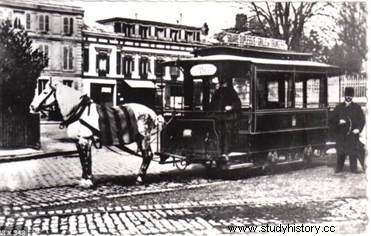 The tramway , a collective transport vehicle with electric traction running on rails, is an American invention. It was New Yorker John Stephenson who, in 1832, built the first horse-drawn line between Manhattan and Harlem. After having conquered many cities whose topography was suitable for its development, the tramway declined in the face of other modes of transport before experiencing a comeback motivated by environmental considerations.
The tramway , a collective transport vehicle with electric traction running on rails, is an American invention. It was New Yorker John Stephenson who, in 1832, built the first horse-drawn line between Manhattan and Harlem. After having conquered many cities whose topography was suitable for its development, the tramway declined in the face of other modes of transport before experiencing a comeback motivated by environmental considerations.
The Tramway is setting up in major cities
The ancestor of the tramway, which was pulled by horses, was probably born in the United States, where a regular line operated between the center of New York and Harlem, from 1832. Very quickly, most of the other large American cities had them. Between 1850 and 1870, this horse-drawn tramway was exported to Europe, settling in the major capitals, from Copenhagen to Geneva and from The Hague to Budapest, via Brussels, Berlin and Vienna. In 1853, during the Universal Exhibition, a test line was presented in Paris.
 After the war of 1870, the tram - still horse-drawn - was established in all major cities in France like abroad. But animal traction proved to be very expensive because the companies had to have innumerable cavalry. That is why trams pulled by a small steam locomotive were introduced, especially in suburban areas. In San Francisco, a cable traction system was installed in 1873:these are the famous cable cars, still in operation.
After the war of 1870, the tram - still horse-drawn - was established in all major cities in France like abroad. But animal traction proved to be very expensive because the companies had to have innumerable cavalry. That is why trams pulled by a small steam locomotive were introduced, especially in suburban areas. In San Francisco, a cable traction system was installed in 1873:these are the famous cable cars, still in operation.
It was at the end of the century that the electric tramway imposed itself under the impetus of the German engineer Werner von Siemens, in Europe, and the American industrialist Frank Julian Sprague, in America. This new technology spread rapidly in the United States, while in Europe it took two decades of effort to get reluctant municipalities to accept overhead contact line power. In France, the first lines of this type operated in Clermont-Ferrand from 1890, and in Marseille from 1893. In the last years of the century, the electrification of tram networks took place systematically in all the cities concerned. with the exception of Paris, which is still hostile to overhead wires.
The return of the tramway to France
While in most countries, efforts are made to run their trams outside car traffic, i.e. on an independent platform, France, on the contrary, adopted a policy of uncontrolled development of the automobile, which led, during the 1950s and 1960s, to the disappearance of most tram networks in favor of buses.
In the 1970s, there was a revival of the tramway in Europe, as part of a policy of developing public transport. If certain networks were reduced or disappeared in favor of the metros, others were extended or were installed because of the insufficient capacity of the buses. In the centers of the big cities, two schools opposed in the search for a symbiosis with the automobile. Some municipalities, such as Brussels, Antwerp or San Diego, opted for a solution that respects car traffic, by building their trams underground, in order to free the urban space from overhead wires. Other cities, such as Zurich, chose a more radical and courageous solution, preferring to exclude cars in favor of trams alone. In France, this "soft" transport now equips around thirty cities, and many other projects are under construction or under study...
To go further
- From the history of transport to the history of mobility. PU Rennes, 2019.
- Short stories of transport:Or how the means of transport have evolved since their invention by Pierre LEFEVRE. bayard, 2014.
